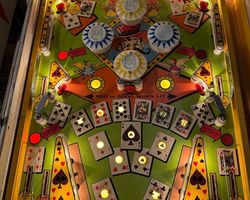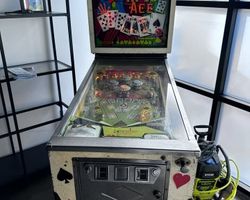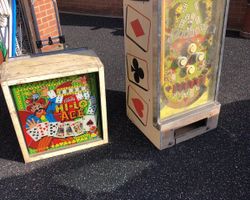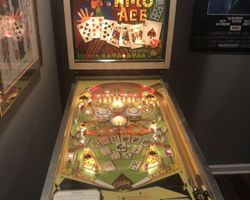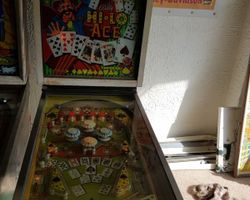Hi-Lo Ace

Average Prices: USD $200 to $1,100
Produced: October, 1973
Production Run: 2,500 units
Machine Type: Electro-mechanical
Players: 1
Design by: Jim Patla
Art by: Dick White
Bally Manufacturing Corporation, a name synonymous with pinball innovation during the Electro-Mechanical (EM) era, introduced a distinctive machine to arcades and homes in October 1973: "Hi-Lo Ace." Designed by Jim Patla with artwork by Dick White, this single-player pinball machine drew players into a world of cards and chance, featuring a theme that resonated with the era's entertainment landscape. With a production run of 2,500 units, Hi-Lo Ace became a notable entry in Bally's robust 1973 lineup, embodying the craftsmanship and play mechanics characteristic of EM machines before the full transition to solid-state technology. Patla’s design philosophy for Hi-Lo Ace focused on a clear, engaging objective, while White’s artistic talent brought the card theme to life, creating a cohesive and visually appealing experience that stood out on location.
Signature Features and Design
Hi-Lo Ace distinguishes itself through a fusion of engaging mechanics and a vibrant aesthetic. The machine’s central feature, and a significant contributor to its enduring appeal, is the "add-a-ball" mechanic. Unlike many machines where a ball lost means the end of a turn, Hi-Lo Ace provided opportunities to earn additional balls, extending gameplay and adding a layer of strategic depth as players aimed to prolong their sessions. This feature encouraged a different style of play, rewarding consistent performance with longer, more involved games.
Visually, Dick White's artwork is a defining element. The playfield and backglass are adorned with stylized playing card motifs, featuring kings, queens, and aces in a colorful, inviting palette. This theme is not merely decorative; it is deeply integrated into the gameplay, as specific targets on the playfield correspond to "high cards," "low cards," and the coveted "Ace." As players hit these targets, the corresponding card figures on the playfield illuminate, providing clear visual feedback of their progress. The auditory experience is equally classic, with the distinct chimes and bells characteristic of EM machines providing a satisfying sonic punctuation to scoring and feature activation, a sound cherished by pinball enthusiasts.
Playfield and Mechanics
The playfield of Hi-Lo Ace presents a well-structured layout that balances open space with strategic targets, encouraging both precise shots and chaotic bumper action. At the heart of the playfield lies a prominent cluster of four pop bumpers. These bumpers are positioned centrally, ensuring that balls frequently enter their dynamic field, creating high-energy deflections and scoring opportunities. Two flippers at the bottom of the playfield provide the primary means of ball control, allowing players to direct shots towards various objectives.
The primary scoring objectives are distributed across the playfield as a series of seven standup targets and multiple rollover lanes. Particularly important are the standup targets positioned in the upper and side corners, which directly contribute to lighting up the "high card," "low card," and "Ace" objectives. The layout encourages shots that navigate the pop bumper area to reach these perimeter targets. Two slingshot mechanisms flank the flippers, propelling the ball back into play with force when struck. The overall design philosophy emphasizes continuous ball movement and a clear progression towards achieving the card sets. The artwork on the playfield guides the player's eye towards these key targets, with the lighting reinforcing the game's central card theme as players advance through their objectives. The machine's robust construction, typical of Bally EMs from this period, included numerous switch stacks, contributing to its solid, substantial feel.
Gameplay Dynamics
Hi-Lo Ace's gameplay revolves around a clear, intuitive objective: completing the "high card," "low card," and "Ace" objectives to earn specials and extend the game. Players begin by aiming for specific standup targets and rollover lanes that correspond to these card categories. Successfully lighting up all the cards within a category, such as "high cards," not only rewards points but also progresses the player towards earning a special. The visual feedback of the illuminated cards on the playfield provides immediate reinforcement, driving player engagement.
The "add-a-ball" feature plays a crucial role in the game's flow and strategy. Earning an extra ball allows for longer games, transforming a quick session into an extended challenge. This mechanic encourages players to take calculated risks and execute precise shots, as successful progression can lead to continued play. The scoring system primarily focuses on accumulating points while simultaneously working towards the card objectives, with specials often providing replays. Hi-Lo Ace is also noted for its responsiveness to player nudging, a skill that experienced pinball players utilize to influence ball trajectory and prevent drains. This interactivity adds a physical dimension to the gameplay, allowing players to apply their finesse and knowledge of the machine's physics. While some players find the shot variety somewhat concentrated on the side targets, the dynamic action provided by the central pop bumpers and the pursuit of the "add-a-ball" feature offer a compelling and often prolonged experience.
Reception and Legacy
Upon its release and in the decades since, Hi-Lo Ace has garnered a moderately positive reception within the pinball community, achieving an average rating that reflects its solid standing as an EM era machine. Its strengths are frequently cited, especially for its appeal as a home pinball machine. Enthusiasts appreciate its classic EM charm, characterized by the satisfying sound of its chimes and the tactile feedback of its mechanical components. The card theme and its vibrant artwork are consistently praised as well-executed, with many finding the visual progression of the lit card features particularly engaging. The "add-a-ball" feature remains a significant highlight, leading to extended, more satisfying games, a trait especially valued in a home environment where long plays are often preferred. Its relatively affordable price point and frequent availability on the used market also make it an attractive entry point for new collectors seeking their first pinball machine. Some players have also noted similarities in its play style to games from Gottlieb, another prominent manufacturer of the era, which is often seen as a positive comparison.
However, Hi-Lo Ace is not without its criticisms. A common point of discussion centers on its perceived limited shot variety, with some players finding that many shots gravitate towards the same side standup targets, potentially leading to repetitive gameplay over multiple sessions. While the central pop bumpers provide action, a minority view suggests they sometimes dominate the playfield, reducing strategic shot opportunities. Additionally, some players have commented on a subjective "disconnect" in the flipper feel, a characteristic sometimes attributed to Bally machines of that period. The internal motors, necessary for the machine's mechanical operations, can also make it noticeably noisy. Despite these points, Hi-Lo Ace's legacy as a fun, accessible, and thematically cohesive EM pinball machine endures. It serves as a representative example of Bally's output in the early 1970s, showcasing the company's ability to create enjoyable and robust machines that continue to find appreciation among collectors and casual players alike.
Sponsored Links
 Ebay Listings
Ebay Listings
 Auction Results
Auction Results
| Cost | Location | Date |
|---|---|---|
| USD $4,500 |  Washington, United States Washington, United States |
29 May, 2025 |
| USD $810 |  California, United States California, United States |
07 May, 2025 |
| USD $2,300 |  Pennsylvania, United States Pennsylvania, United States |
23 April, 2025 |
| GBP £500 |  United Kingdom United Kingdom |
08 October, 2024 |
| USD $500 |  Kentucky, United States Kentucky, United States |
24 November, 2021 |
| USD $2,795 |  Illinois, United States Illinois, United States |
20 February, 2021 |
| USD $1,878 |  Florida, United States Florida, United States |
14 December, 2020 |
| GBP £621 |  Pontefract, United Kingdom Pontefract, United Kingdom |
30 December, 2019 |
| GBP £499 |  United Kingdom United Kingdom |
25 August, 2019 |
| GBP £250 |  Manchester, United Kingdom Manchester, United Kingdom |
06 July, 2019 |


Private Policy · Search Website · Contact Us
As an eBay Partner, we may earn a commission from qualifying purchases made through links on this site, at no additional cost to you.
All trademarks and copyrighted materials remain property of their respective owners. All other content copyright 2007 - 2026 Pinpedia.

